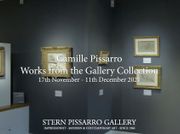Camille Pissarro was a French landscape painter and printmaker who is renowned for his contributions to the Impressionist and Post-Impressionist movements.
Read MorePissarro was born on the island of St. Thomas in the Danish West Indies to a family of merchants. Sent away to boarding school in Passy near Paris at the age of 12, Pissarro showed an early talent for drawing and became a regular at the Louvre. The artist expressed little interest in the family business once he returned, opting rather to sketch at the harbor.
In 1852, Pissarro sailed to Venezuela with Danish painter Fritz Melbye, where he sketched the streets of Caracas. Melbye inspired Pissarro to become a painter and became the young artist's mentor and close friend. Pissarro returned to St. Thomas in 1855 and set off for Paris that year.
In Paris, Pissarro studied at the École des Beaux-Arts and the Académie Suisse under influential painters like Gustave Courbet and Jean Corot, whose works Pissarro first encountered at the Universal Exposition in Paris and deeply marked the young artist.
Conforming to Salon standards, Pissarro's early paintings depict scenes from his native West Indies. They were first shown at the Paris Salon of 1859 and bore notes of Corot's influence, with rivers and paths receding in perspective and figures seen from the back.
Painted in nature, Camille Pissarro's landscapes and portraits depict the French countryside and cityscapes across vivid scenes that replicate the sensations of light and changes in temperature as experienced by the painter.
Pissarro's time spent in rural regions like Montmorency and Pontoise, where nature was ample, inspired subject matter like the green countryside of Jalais Hill, Pontoise (1867) and established a lifelong habit of painting outside of Paris.
Deemed by French writer and cultural critic Émile Zola as an exemplary modern landscape, the work was received favourably by the Salon and positioned Pissarro as an avantgarde landscape painter, despite his growing reluctance to exhibit with the institution.
Pissarro became increasingly vocal about the inequities of the École des Beaux-Arts and the Salon's jury system, which disadvantaged smaller paintings. These ideas were shared with younger artists like Claude Monet and Auguste Renoir, who referred to him as 'Father Pissarro'.
When the Franco-German War broke out in 1870, Pissarro joined his mother and brother in London, where he worked alongside Monet, painting scenes like The Crystal Palace (1871), which captured the emerging middle-class homes in the neighbouring town of Sydenham.
Back in Paris, Pissarro founded a society with its own charter as an alternative to the Paris Salon. The collective held its first exhibition in 1874 at the studio of photographer Nadar, for which Pissarro showed five paintings. The show later became known as the first Impressionist exhibition.
Amongst the artists exhibiting were also Monet, Renoir, Paul Cézanne, and Edgar Degas, all of whom shared Pissarro's desire to document the modern world through the transient effects of colour and light, favouring tone and texture over traditional modelling and landscape compositions.
An unfavourable critical response paired with financial difficulties and the death of Pissarro's nine-year-old daughter framed the group's second exhibition in 1876, after which existing members gradually retreated, while new additions to the collective generated an internal rift.
Pissarro endeavoured to keep the group together and continued to pursue an Impressionist style with works such as Young Peasant Woman Having her Coffee (1881). This painting served as a study of colour division, in which the blue green of the wall is reflected against the girl's pink blouse in small dots.
Despite increasing financial difficulties, Pissarro held on to his convictions. An 1884 encounter with Pierre Signac and Georges Seurat refined his existing technique, which layered dots of contrasting pigments perceived as a single hue, and later became known as Neo-Impressionism.
Just as quickly, Pissarro moved away from this way of painting, claiming it made it 'impossible to be true to [his] sensations'. By the 8th and final Impressionist Exhibition, the movement had run its course, while the conditions in the art world that once made the group's exhibitions necessary had changed.
By 1890, Pissarro returned to painting cityscapes, just as his peers were setting them aside. He completed several views of Paris, working on multiple canvases at once to explore and express changes in weather and light.
Pissarro suffered an eye infection near the end of his life which affected his ability to paint outside. He passed away from sepsis in 1903 in Paris.
Camille Pissarro's works are widely recognised and held in museum collections around the world.
Select solo exhibitions include Ashmolean Museum, Oxford (2022); Kunstmuseum Basel (2021); Stern Pissarro Gallery, London (2021); Dulwich Picture Gallery, London (2019); Van Gogh Museum, Amsterdam (2019); Museo Nacional Thyssen-Bornemisza, Madrid (2013); and National Gallery of Art, Washington, D.C. (2012).
Select group exhibitions include Columbus Museum of Art, Ohio (2021); The Museum of Fine Arts, Houston (2021); The Jewish Museum, New York (2021); National Gallery of Canada, Ottawa (2021); Museum of Fine Arts, Boston (2021); Foundation de L'Hermitage, Lausanne (2021); Atelier des Lumières, Paris (2020); Royal Academy of Arts, London (2020); and Helene Bailly Gallery, Paris (2020).
Pissarro's paintings and prints are sold at major auction houses, including Sotheby's and Christie's, with an auction record of US $32 million.
The artist's website can be found here.
Elaine YJ Zheng | Ocula | 2022




